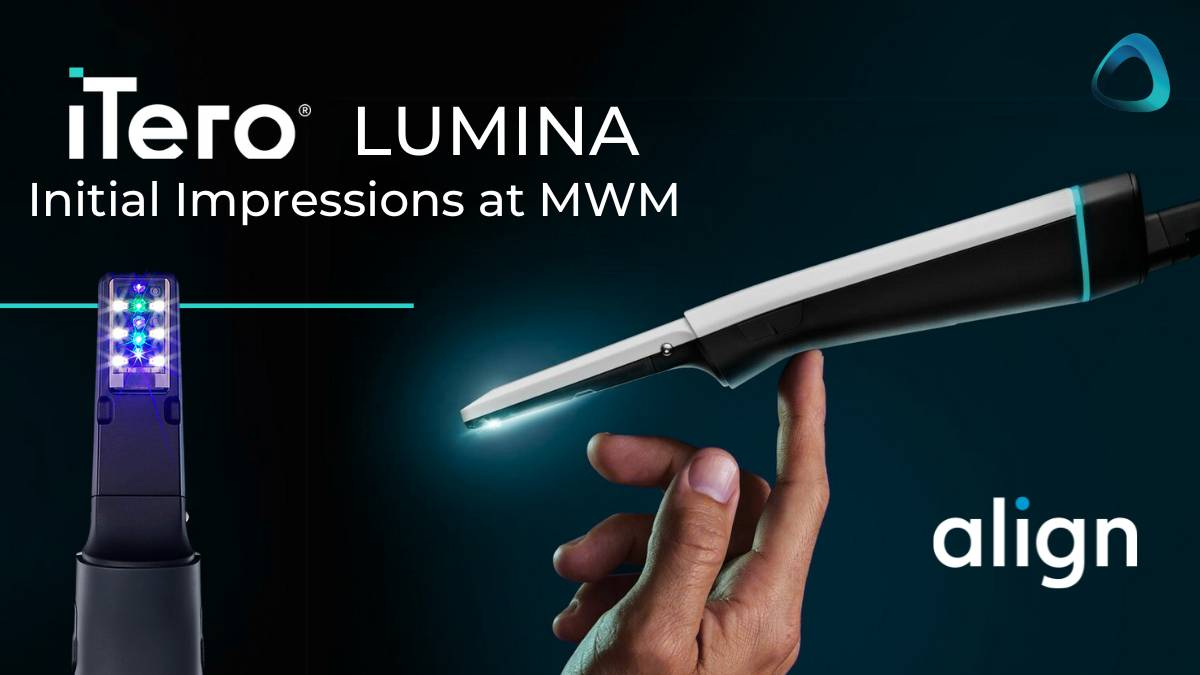One of the most exciting new releases at the Chicago Midwinter Meeting was Align Technology’s iTero Lumina.
This is their first new scanner release since 2019! Hence, I was really excited to get a hands-on first look at the Chicago Mid Winter event.
So here are my first impressions. To see our full recap of the iTero Lumina 2024 launch, click here.
iTero Lumina Price
One of the glaring omissions from the launch event a few weeks ago was any mention of price.
The company told me that the iTero Lumina will be priced around the $45,000 - $50,000 USD mark.
It’s common knowledge that scanner prices are on a downward trend, and most companies are trying to price their scanners to be competitive with the new affordable scanners that seem to hit the market regularly.
Many companies even introduce a low-cost scanner to their portfolio to capture market share.
The approximately $45,000 USD price point is slightly surprising. It’s quite high for a scanner these days, and I think it might affect how many new dentists will shift over to the iTero brand or upgrade.
In saying that, the Align and iTero brands are one of the strongest in the industry. The company is clear they are not going to cheapen their brand by being part of the price war going on. Rather they will provide a better solution than anyone else.
It’s important to note that the price doesn’t include any specials or trade-ins, so you might get a better deal if you’re looking for an upgrade, but it will be interesting to see if a scanner priced at the premium end of the market will properly take off.
iTero’s Improved Scanning Experience with the Lumina
The iTero Lumina is super fast - exactly as I wanted to see.
It is as fast as any other scanner on the market now. I could scan a full arch model within 30 seconds.
The iTero Lumina is also very slim, light, and quite impressive in this aspect. Especially when considering the previous iTero scanners.
It’s much better than any other iTero scanner, so to be honest this should be the only iTero anyone considers anymore. It’s a huge upgrade from what Align has previously released.
Interestingly, the scanner is not wireless. Which is a trend we are seeing from other market leaders like Medit and TRIOS.
Here are some videos of me using the iTero Lumina.
iTero Lumina Single-Use Scanning Sleeves
The scanning sleeves are still for one-time use and will cost the same as the Element 5D sleeves.
The sleeves are much firmer now. They're not like that pliable plastic that was previously used.
It's a much more firm plastic and clicks in and out.
You can see what I mean in the video below.
How Good is the iTero Lumina Multi-Direct Capture Technology?
Something Align Technology seemed really excited about is iTero Lumina’s Multi-Direct Capture Technology.
Having tested the scanner, I can now see why.
They have brought the capture technology to the tip of the scanner rather than using mirror tips to reflect the light to a sensor in the rear of the scanner body.
With scanners, the field of capture is very important. A larger field of capture allows for a faster scan with fewer stitching errors, but a large field of scan has previously meant a larger scanner - which isn’t always ideal for clinical use.
The Lumina’s field of view is absolutely massive. The scanning window is huge. The result of all of this is that it captures a lot of data quickly.
For example when scanning an upper arch, I found it had captured a lot of the palate just while focussing on scanning the teeth themselves. It picks up the palate really easily.
At first I was concerned that the large depth of field will mean the scanner will capture a lot of soft tissue but to my surprise the software is very good at filtering the cheeks and tongue when scanning. When I scanned my mouth at the booth, it wasn't picking up my tongue, so the algorithm is fine-tuned.
After trying out the iTero Lumina for the first time, it was interesting - although the price point is definitely going to put a few people off I think this scanner puts iTero back in the game. Align should be proud of this release.
I’m really interested to try it out in a clinical setting, so stay tuned for a review in the near future.


You said earlier article that the software for crown bridge works would come. Have you tried that and what do you think of the itero in connection with korner bridge, How does it work? And how do you find the software?
They originally said it will be released Q3 of 2024. But they have delayed that until Q1 2025. So we are all waiting for it 🙂
Hello Dr Hassiny
I am excited to see new iTero lumina and also shock to see that how advanced digital dentistry.whenever I have a chance to use it.